
by Matt Lollar | Oct 8, 2024
On a recent family walk, I noticed something pretty obvious. One of our neighbors had a broken irrigation head. Luckily this is an easy fix, because a new rotor can just be screwed into place. But seeing the amount of water running into the street got me thinking about some additional ways to save water. Scroll down for some water saving tips based on the 9 Principles for Florida Friendly Landscaping.
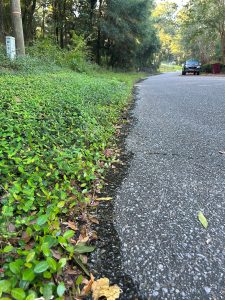
Water runoff from a broken irrigation head. Photo Credit: Matt Lollar, University of Florida/IFAS Extension – Santa Rosa County
4 Ways to Save Water
- Pick the right plant for the right place. Turf is an excellent choice for catching runoff in the situation pictured above. However, it’s important to evaluate your yard based on the amount of sunlight received throughout the day. Once you’ve determined if you need sun loving, shade loving, or plants that can handle a little of both, you’ll want to check how well your soil drains. Some plants can handle wet conditions better than others. Use the FFL Plant Guide to help pick the plants for your space.
- Irrigate based on plant requirements. Plants like to be watered thoroughly to the extent of their rootzones. For turf, we recommend irrigating deeply and infrequently early in the morning. This method encourages the roots to grow deep to reach the water needed. Most established trees and shrubs don’t need supplemental irrigation unless we’re going through an extended period of drought. Review the Summary of Turf and Landscape Irrigation Recommendations to help determine the amount of water your yard needs.
- Calibrate the irrigation system. If you have an irrigation system, then you need to make sure it’s calibrated. To do this, you’ll first need to make sure your system doesn’t have any leaks or broken heads and redirect heads to water plants instead of the driveway, sidewalk, or road. Next, you’ll need to determine how long to run your system based on water output. The run time test is detailed on the UF/IFAS Calibrating Your Irrigation System webpage.
- Use mulch around trees and shrubs. Mulch can help hold moisture and conserve water. It’s important to keep mulch to between 2 and 3 inches deep and at least 2 inches away from the base of trees and shrubs. There’s a lot more information on Choosing and Installing Mulches on the Gardening Solutions website.
Following these simple tips will ensure that you’re watering efficiently and effectively. If you have additional questions about irrigation or just about anything plant related, please contact your local UF/IFAS Extension Office.
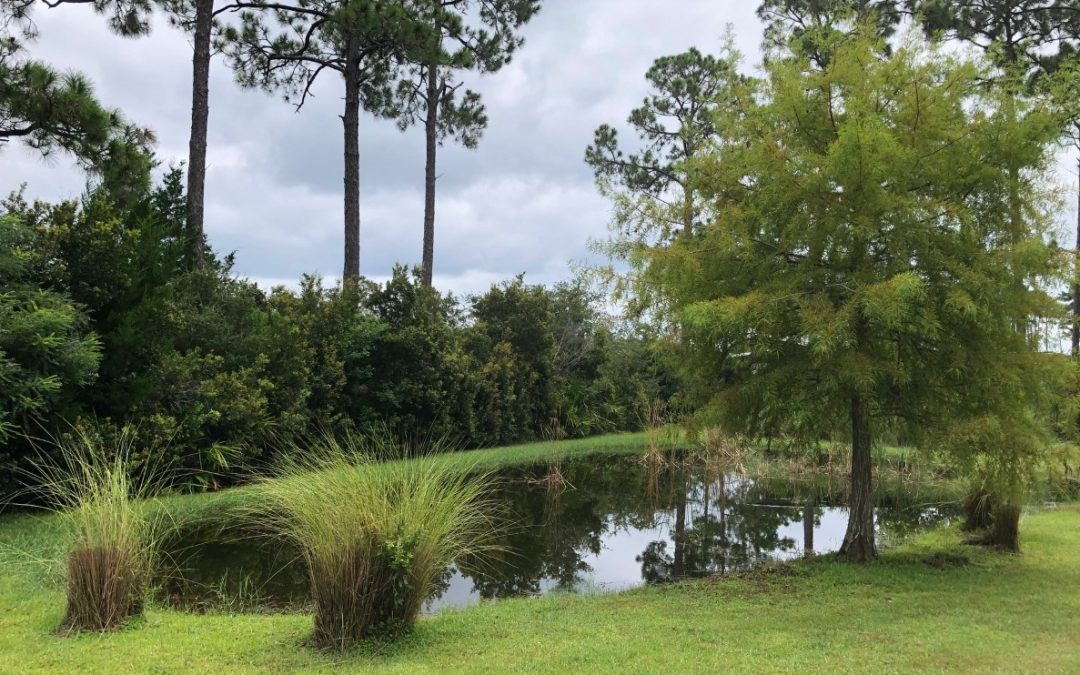
by Stephen Greer | Aug 11, 2021
One big goal of establishing a home lawn and landscape is to enjoy an attractive setting for family and friends, while also helping manage healthy soils and plants. Soil compaction at these sites can cause multiple problems for quality plants establishment and growth. Soil is an incredibly important resource creating the foundation for plants and water absorption.
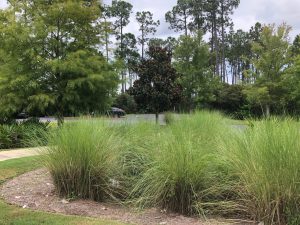
Photo courtesy: Stephen Greer, UF IFAS
Soils are composed of many different things, including minerals. In Florida, these minerals often include sand of differing sizes and clay in the northern area of the counties in the panhandle of Florida. Soil is also composed of organic matter, nutrients, microorganisms and others. When soil compacts, the air spaces between the sand or clay are compressed, reducing the space between the mineral particles. This can occur anytime during the landscape and lawn construction phase or during long term maintenance of the area with equipment that could include tractors, mowers, and trucks.
What can be done to reduce soil compaction? There are steps that can be taken to help reduce this serious situation. Make a plan on how to best approach a given land area with the equipment needed to accomplish the landscape of your dreams. Where should heavy equipment travel and how much impact they will have to the soils, trees, and other plants already existing and others to be planted? At times heavy plywood may be needed to distribute the tire weight load over a larger area, reducing soil compaction by a tire directly on the soil. Once the big equipment use is complete, look at ways to reduce the areas that were compacted. Incorporating organic matter such as compost, pine bark, mulch, and others by tilling the soil and mixing it with the existing soil can help. Anytime the soil provides improved air space, root will better grow and penetrate larger areas of the soil and plants will be healthier.
Even light foot traffic over the same area over and over will slowly compact soils. Take a look at golf course at the end of cart paths or during a tournament with people walking over the same areas. The grass is damaged from the leaves at the surface to the roots below. Plugging these areas or possibly tilling and reestablishing these sites to reduce the compacted soils may be necessary.
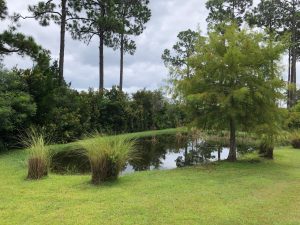
Photo courtesy: Stephen Greer, UF IFAS
Water absorption is another area to plan for, as heavy rains do occur in Florida. Having landscapes and lawns that are properly managed allow increased water infiltration into the soil is critically important. Water runoff from the site is reduced or at least slowed to allow the nutrient from fertilizers used for the plant to have more time to be absorbed into the soil and taken up by the plants. This reduces the opportunity for nitrogen, phosphorus, and other nutrients to enter water areas such as ponds, creeks, lagoons, rivers and bays. Even if you are miles from an open water source, movement of water runoff can enter ditches and work their way to these open water areas, ultimately impacting drinking water, wildlife, and unwanted aquatic plant growth.
Plan ahead and talk with experts that can help with developing a plan. Contact your local Extension office for assistance!
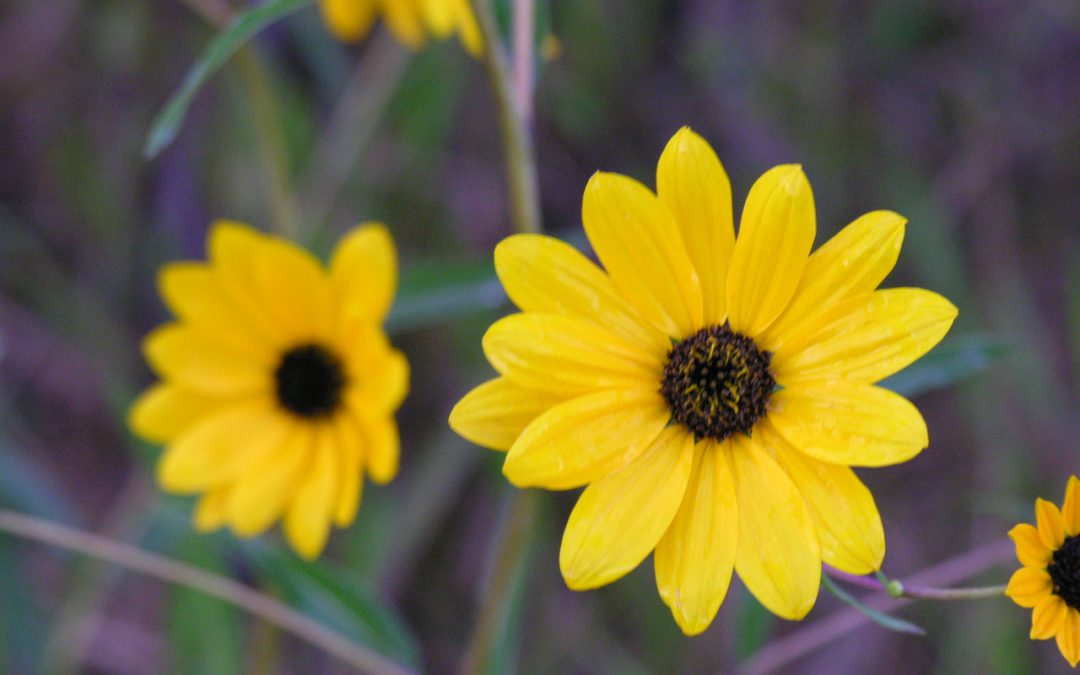
by Taylor Vandiver | Apr 14, 2015
Rain gardens are an easy way to return water to our aquifer, reduce erosion, and help prevent stormwater runoff.
Running down the driveway or patio, rainwater can pick up lawn chemicals and pesticides. A rain garden is basically a low section of the landscape planted with native plants that like to get their “feet” wet. The garden collects rainwater, giving it a chance to “strain” out impurities before draining into the aquifer.

Swamp sunflower. Photo courtesy UF/IFAS.
They work best when they’re placed at the bottom of downspouts or naturally low spots in the landscape, usually where water tends to puddle. They’re especially useful for collecting runoff from paved surfaces. Rain gardens can be any size or shape and can attract thirsty wildlife.
When selecting plants, you’ll need to consider how much sun your site gets and how much space is available. Make sure you select plants that are not just water-tolerant, but also drought-tolerant for the times between rains.
Rain gardens rely on plants that will survive dry spells but then soak up excess stormwater during Florida’s rainy months, preventing the water from running across your landscape.
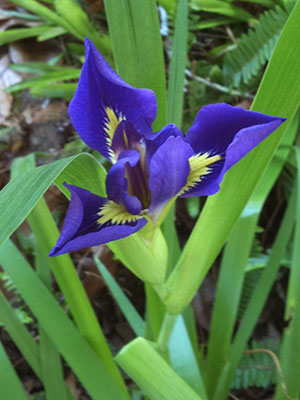
Blue flag iris. Photo courtesy UF/IFAS.
Include different types of plants in your rain garden to create a complete and cohesive look that will provide year-round interest. The following is a short list of flowers, shrubs, and grasses that would perform well in a rain garden.
Flowers:
- Blue flag iris
- Goldenrod
- Swamp sunflower
- Spider lily
- Milkweed
Grasses:
- Florida gamma grass
- Muhly grass
- Wiregrass
Shrubs:
- Virginia willow
- Buttonbush
- Wax myrtle
Here is a list of native plants that will do well in your North Florida rain garden. As always consult your local Extension Office for more information. All of the information in this article was provided by UF/IFAS Extension.








